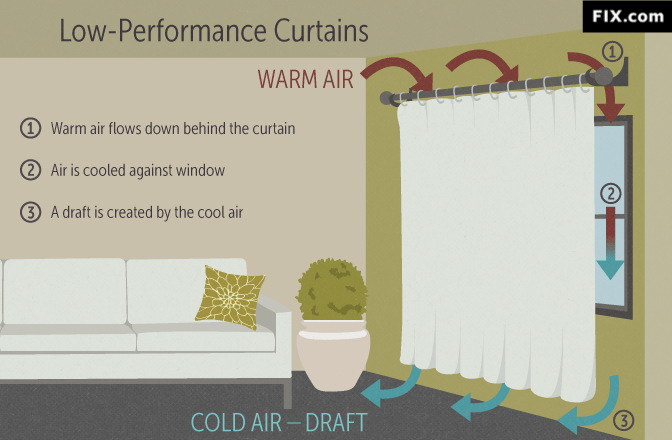House Insulation: Winter Curtains
Updated: Mar. 07, 2024
How to get insulation from your curtains.
by Nelson Lebo for Fix.com
Windows provide us with so many benefits – natural daylight, a quaint view. But during the winter months they become holes in the sides of our homes, letting out all our coveted heat. The best fix for this is curtains. Basically winter insulation for windows, curtains create an air gap between the room and the glass. But unfortunately, the vast majority of curtains do not hold the warmth as well as they should. Here’s what you need to know about best thermal curtains for winter.

Window Pain
Single-glazing? Double-glazing? Storm windows? Any way they come, windows are the problem with the thermal envelope of our homes. In many cases, even an uninsulated wall has a higher insulating capacity (R-value) than double-glazed windows.
There is no international standard for R-values. This article describes thermal properties in relative terms rather than specific units.
No matter how great your windows look, heat will always escape them. Windows should have a properly fitted curtain. A major problem is that most curtains are not fitted to maximize their insulating capacity, and most people don’t know it.
Editor’s Tip: There’s nothing more disruptive to a night of sleep than excessive sound apart from a cold chilly breeze, these seemingly minor noises can have an outsized impact on your well-being. So, turn to soundproof curtains to block out some of the din.
The Problem
Many curtain tracks consist of brackets that hold a track 4 to 5 cm (1.5 inches) out from the wall. We call this style an “open-top” curtain track because of the narrow gap between the top of the curtain and the wall. Even though the gap size can be adjusted, any gap whatsoever diminishes the thermal performance of the window area.

The illustration above is of a typical open-top, free-hanging curtain. When the window is cold, the warm air between the curtain and the window cools as heat radiates out through the glass. As sure as warm air rises, cool air sinks. In this case, the cooling air falls to the floor, creating negative pressure (a vacuum), which pulls warm air down from the ceiling through the gap at the top of the curtain. This process is cyclical, and your warm room loses heat.
This heat loss proceeds from sunset to sunrise as long there’s a temperature difference between indoors and outdoors. Depending on your latitude, winter nights can be long enough to lose a considerable amount of heat from what otherwise is a well-insulated home.
The Solution
Now that we understand the problem, the solution should appear logical. The best way to stop the flow of air behind the curtain is to install a “pelmet”: a cornice or valance that covers the top of a curtain rail. A pelmet can either come down from the ceiling to cover the top of a curtain or be attached to the wall immediately above a window. The latter is often called a “box pelmet” and should have closed sides as the name implies. Either type of pelmet should cover the top of the curtain by about 2 inches.

The second way to slow the movement of air behind the curtain is to replace a free-hanging curtain with one that is floor-length. Just like the pelmet blocks airflow from the top of a curtain, the floor-length fabric blocks the free movement of air out of the bottom. Either way, the idea is to break the cycle of moving air.
Some people may choose not to embrace either of these strategies because of their budget or aesthetics. Fortunately, there are other low-cost options that are nearly as effective. Check out the Fix.com article for tips for weatherizing your home.
The Thermal Conclusion
Once your curtains are draft-proof, the next crucial factor is their insulation capacity – two layers of fabric at least. Insulation is all about dead air space: the more layers, the more dead air. Adding a fabric layer between the curtain and the lining makes a super high-performance insulation system for windows. Research has shown that having well-fitted layered curtains results in an R-value equal to or greater than double-glazing, yet at a fraction of the cost.
Does putting plastic on your windows save energy? Find out here!